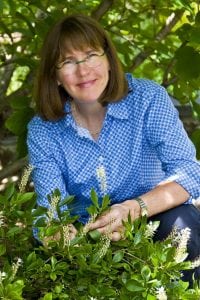By Pamela Doan
It’s going on a decade now that the news about bees has been grim. About a third of the population is dying off on average every year, according to recent statistics. Beekeepers and researchers have been looking for causes of what’s been termed colony collapse disorder and a few factors have been identified as contributing to these stunning losses.
Insecticides, a new class specifically called neonicotinoids, are one of the main suspects, along with parasites and viruses. Insecticides that are absorbed by the plant or tree also are found in pollen and nectar and kill bees and butterflies, too. The Xerces Society, a non-profit based in Oregon that does research, education and advocacy work, has a helpful list of brand name insecticides that contain neonicotinoids.
For native bees, the loss of supportive habitat underlies their problems. As more land is developed, bees lose access to the plants they depend on for food.
The good news is that two of these things can be directly impacted by the efforts of gardeners. Consider reducing or eliminating the use of pesticides in the home landscape. Whether it’s chemicals that are applied to lawns, flowers or vegetables, each one has an impact on the ecosystem that’s far reaching.

Take care to read labels and be as specific as possible in targeting the actual nuisance or threat. Learning to tolerate a bit of imperfection in plants is also necessary. The grass might be lush and green, but at what cost? Finally, seek out alternatives to insecticides. A great local resource, the Cornell Cooperative Extension office in Putnam County, has a hotline and diagnostic lab that can identify pests and offer advice on ways to manage it. Unlike the staff at a landscape center or big box store, the CCE doesn’t have an interest in selling products and comes from a research-tested perspective when they suggest strategies.
Kim Eierman, an environmental horticulturist, has a special focus on bees and native plants. When planting for bees, she emphasizes that diversity is the key.
“The size of a bee and its tongue length also determine what plants a given bee can use for nectar and/or pollen,” Eierman said. “Shorter-tongued bees will not be able to access long tubular flowers, which are easy for longer-tongued bees to utilize. Large bumblebees are quite strong and can force open flowers on plants such as Turtlehead to obtain a nectar reward. Small sweat bees will gravitate to smaller, more open flowers on plants such as Wild Quinine.”
Gardeners who are planting for bees need to consider what’s available in the spring, summer and fall. Eierman provided a list of native plants that she recommends. All of the selections are plants that will grow in our area. Eierman supplied the names of plants and I added comments about it.
Spring Flowering Natives
Note that many early flowering trees and shrubs are important for native bees and honey bees.
Anemone (Anemone species) — this group is diverse and includes both bulbs and perennials. They’re also called windflowers.
Beard Tongue (Penstemon species) — this perennial can be found in many colors and is also called foxglove beardtongue.
Wild Geranium (Geranium maculatum) — this one will grow in shade and is long blooming for several months with pink, white or lavender flowers.
Summer Flowering Natives
Anise Hyssop (Agastache foeniculum) — this lovely herb/flowering perennial is 2 to 4 feet tall with profuse purple flowers.
Blazing Stars (Liatris species) — another perennial with showy purple flowers that are also good in vases.
Joe-Pye Weeds (Eutrochium, Eupatoriadelphus species) — this native perennial can grow up to 6 feet tall and flowers at the top of the stalk with a head comprised of several branches with tiny flowers.
Fall Flowering Natives
Asters (Symphyotrichum, Eurybia species) — these are fragrant pink or lavender-blue flowering perennials.
Goldenrods (Solidago species) — there are more than 30 different goldenrods that are native here and these perennials can have blue, white or yellow flowers. Take your pick!
Sunflowers (Helianthus species) — sunflowers are easy to grow from seed and come in many shapes and sizes.
Hear more from Kim Eierman at a talk sponsored by the Putnam County Master Gardeners, EcoBeneficial Gardening 101: Boosting the Ecosystem in Your Own Yard, from 9:45 a.m. to noon on Saturday, May 3, at the Lasdon Park and Arboretum, Katonah. For more information and tickets, call Dan Feeser at 845-278-6738.
